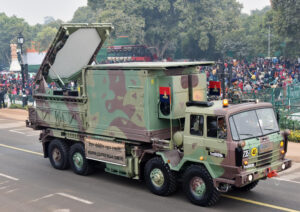Context

The Indian Army is modernizing its Air Defence (AD) radar systems to tackle new-age threats like low-cost drones with small radar signatures. This upgrade is a key step to strengthen India’s defence network along the northern and western borders, especially after challenges faced during Operation Sindoor, where Pakistani Unmanned Aerial Vehicles (UAVs) infiltrated Indian airspace.
Key Developments
- The Army is procuring advanced surveillance and fire control radars to improve detection and neutralization of aerial threats.
- The new radars will:
- Track low-flying aerial threats such as drones and small UAVs.
- Enhance detection of aerial objects with small radar cross-sections (RCS).
- Integrate with missile and gun systems for air defence.
Types of Radars Being Procured
- Low-Level Light Weight Radars (LLWR) & Upgraded LLWRs
- Mobile surveillance radars.
- Specifically designed to detect and track small, low-flying targets.
- ADFCR-DD (Air Defence Fire Control Radar – Drone Detector)
- Mobile radar unit.
- Used to control targeting of weapons against drones.
Why the Upgrade Was Needed
- Many of India’s existing radars were designed to detect conventional aerial threats like aircraft and helicopters but struggled against modern, stealthy drones.
- During Operation Sindoor, UAVs were able to:
- Bypass existing radar systems using low altitude and camouflage techniques.
- Gather intelligence and carry out attacks.
The upgrade will strengthen surveillance and enable India to intercept even the smallest threats, preventing incidents similar to Operation Sindoor.
How Radars Work
- Radar stands for Radio Detection and Ranging.
- It detects objects by:
- Sending out radio waves.
- Analyzing the signal reflected back when it hits an object.
- Key radar functions:
- Surveillance: Scans the airspace for aerial threats (not connected to weapons).
- Fire Control: Directly guides weapons to the target.
Strategic Importance
- These upgraded systems will:
- Provide real-time target tracking.
- Improve airspace management.
- Integrate with India’s multi-layered AD network which includes:
- Akash missiles.
- Surface-to-air missiles.
- Advanced Command and Control Systems (ACCS).
- Strengthen India’s capacity to deter cross-border drone intrusions.
India’s AD Infrastructure
- India’s AD network is a three-tier system:
- Long-range missiles (e.g., S-400 systems).
- Medium-range missiles like Akash.
- Short-range guns and missiles integrated with radar for precision targeting.
This multi-layered system ensures 360-degree defence coverage and rapid neutralization of aerial threats.
Conclusion
The radar upgrades mark a major modernization step for India’s defence forces. By focusing on drone detection and small target tracking, India is adapting to future warfare scenarios, ensuring a more resilient and technologically advanced defence network.




